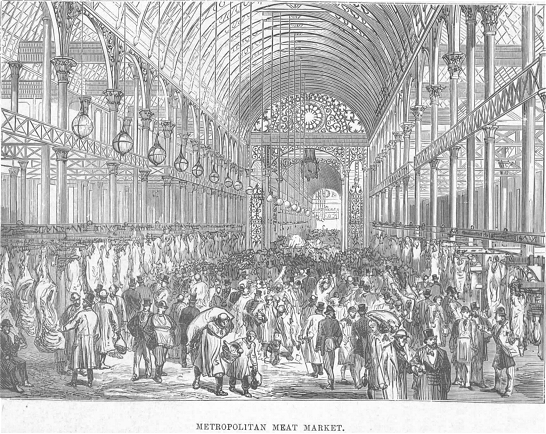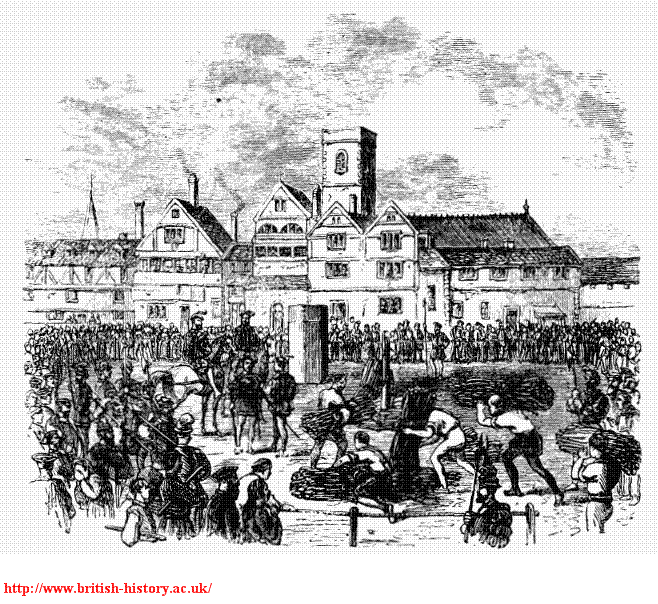Smithfield
Links
British History Online - from the 1878 book Old and New London, comes this very detailed history of the Smithfield area.
Wikipedia - a more modern, briefer, but less colourful history
Mysterious Britain - The Elms, Smithfield - a history of some of the more notable executions that took place here.
Museum of London - the Museum has three videos on the history of Smithfield as well as looking into the future.
Monks, meat and merriment - another page from the excellent Museum of London site - this time essays on religion, the meat market and Bartholomew Fair

I wasn’t going to do anything special on Smithfield, but whilst looking for illustrations for my piece on John Mollett, I found so many lovely old pictures that I thought I would collect them all together in one place. So this page is mostly pictures, with a few links to the history.
Smithfield is London’s meat market - it has been since, medieval times. Before the 1860s it was all in the open air, as in the engraving above. In the 1860s a new covered market was built, and is still used. The selling of the live cattle was moved to the suburbs. On a recent visit I took the photos at left. In the second photo you can see the entrance to the covered market in the background. But in the time when our ancestors lived in and around the area it was a very different place to the trendy area it is today. Charles Dickens features it in his novel Oliver Twist. Here is the impression it makes on Oliver when he first sees it”
“A dirtier or more wretched place he had never seen. The street was very narrow and muddy, and the air was impregnated with filthy odours. There were a good many small shops, but the only stock-in-trade appeared to be heaps of children, who, even at that time of night, were crawling in and out at the doors, or screaming from the inside. The sole places that seemed to prosper amid the general blight of the place were the public-houses, and in them the lowest orders of Irish were wrangling with might and main. Covered ways and yards, which here and there diverged from the main street, disclosed little knots of houses where drunken men and women were positively wallowing in the filth, and from several of the doorways great, ill-looking fellows were cautiously emerging, bound, to all appearance, upon no very well-disposed or harmless errands."
Slightly different from the London office workers enjoying a lunchtime drink on a beautiful summer’s day at left. The pub - the Hook and Cleaver - is very probably original though, and maybe one of those referred to by Dickens.


The British HIstory Online account, from the 1878 book Old and New London, describes the meat market thus:
“Smithfield Market, on a foggy, rainy morning in November, some twenty-five years ago (says Aleph), was a sight to be remembered by any who had ventured through it. It might be called a feat of clever agility to get across Smithfield, on such a greasy, muddy day, without slipping down, or without being knocked over by one of the poor frightened and half-mad cattle toiling through it. The noise was deafening. The bellowing and lowing of cattle, bleating of sheep, squeaking of pigs, the shouts of the drovers, and often, the shrieks of some unfortunate female who had got amongst the unruly, frightened cattle, could not be forgotten. The long, narrow lanes of pavement that crossed the wider part of the market, opposite the hospital, were always lined with cattle, as close together as they could stand, their heads tied to the rails on either side of the scanty pathway, when the long horns of the Spanish breeds, sticking across towards the other side, made it far from a pleasant experience for a nervous man to venture along one of these narrow lanes, albeit it was the nearest and most direct way across the open market. If the day was foggy (and there were more foggy days then than now), then the glaring lights of the drover-boys' torches added to the wild confusion, whilst it did not dispel much of the gloom. It was indeed a very great change for the better when at last the City authorities removed the market into the suburbs.”



An 1810 engraving by George Shepherd (at right)
An 1825 drawing (below)
From Life magazine’s archives comes this engraving (below right



Below - old and new drawings of the the new market of 1888 ...







As well as a meat market Smithfield also has an even grimmer history as the place of execution until this was moved to Tyburn in the nineteenth century. Prior to that it had been the site of many gruesome scenes of torture and execution, including those of William Wallace and Wat Tyler. Newgate prison, and the Old Bailey are close by.
And last, but not least Smithfield is the site of the oldest hospital in London (maybe England), St. Bartholomew’s, now fondly known as St. Barts - for it is still there, next to the old St. Bartholomew’s church. St. Bartholomew’s also gave its name to an annual fair that was held there from 1133 on St Bartholomew’s Day, 24th August. Here is a description of the fair in the seventeenth century:
“It is remarkable, and worth your observation to behold, and hear the strange sights, and confused noise in the fair. here, a knave, in a fool's coat, with a trumpet sounding, or on it drum heating, invites you to see his puppets; there, a rogue like a wild woodman, or in an antic shape like an incubus, desires your company to view his motion; on the other side, Hocuspocus, with three yards of tape or ribbon in his hand, thews his art of legerdemain to the admiration and astonishment of a company of cockloaches. Amongst these, you shall. see a gray goose-cap (as wise as the rest), with a "what do ye lacks.) "in his month, stand in his booth, slinking it rattle or scraping a fiddle, with which children are so taken, that they presently cry out for these fopperies; and all these together make such a distracted noise, that you would think Babel not comparable to it.”
It continued well into the nineteenth century, but I do not think it happens any longer.

Cloth Fair - a small street besides St. Bartholomew’s, named for the fair
St Bartholomew’s Fair in 1808 by Rudolph Ackerman and at left a cartoon by George Cruikshank